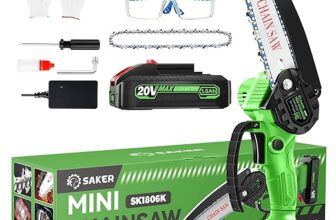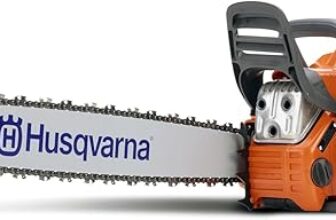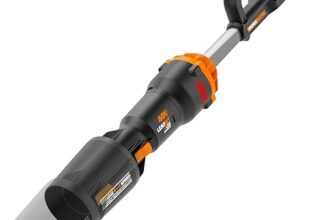
Chainsaw Chain Differences
Understanding Chainsaw Chain Differences
Did you know that using the wrong chainsaw chain can reduce cutting efficiency by up to 30%? Many users underestimate the significance of selecting the right chain, leading to frustration and wasted time during cutting tasks.
In this article, I will explore the various types of chainsaw chains, emphasizing their key differences and suitable applications. Whether you’re a seasoned lumberjack or a weekend warrior tackling a home improvement project, understanding these distinctions can greatly enhance your chainsaw’s performance.
From the intricate geometry and design of the chains to the maintenance required for longevity, each factor plays a critical role in getting the job done efficiently. Join me as I break down the essentials to help you make an informed choice. With the right knowledge, you can maximize your chainsaw’s effectiveness and tackle any cutting challenge with confidence.




Mastering Chainsaw Chains: Full Chisel
Types of Chainsaw Chains
When it comes to chainsaw chains, there’s more diversity than one might initially think. I often find that a little understanding can go a long way toward improving my chainsaw’s performance. So, let’s explore the primary types of chainsaw chains available on the market: standard, low profile, and full-chisel chains.
Standard Chains
Standard chains, also known as full profile chains, are the workhorses of the chainsaw world. They feature full-sized cutting teeth designed for efficient cutting through hardwoods and softwoods alike. Ideal for professional lumberjacks and serious DIYers, they provide a rapid cutting speed due to their aggressive tooth design. However, this speed comes with a trade-off; they may snag more easily, particularly when working in dirty or rugged environments.
Low Profile Chains
In contrast, low profile chains are designed for safety and ease of use, making them perfect for casual users or those working in confined spaces. They have shorter teeth which reduce the risk of kickback—an important consideration for less experienced operators. What I appreciate about low profile chains is that they’re often quieter and less likely to damage the wood, yielding a cleaner cut for lighter tasks such as pruning or trimming. This chain type can be particularly beneficial for tree surgeons or home users who require precision without the added anxiety of sudden recoil.
Full-Chisel Chains
Then there’s the full-chisel chain, known for its square-shaped teeth that cut fast and aggressively. I love how these chains excel in cutting softwoods like pine or fir; they can slice through with speed and precision that feels almost effortless. However, while they offer exceptional cutting performance, I find that they dull more quickly, especially when encountered with dirt or gritty elements. So, they require more frequent sharpening and are better suited for cleaner environments or professional applications.
Choosing the Right Chain
Selecting the right type of chain is crucial, as each chain serves distinct purposes and excels under specific conditions. I often emphasize that understanding your needs—be it casual yard work or full-scale logging—will heavily influence your choice. For my own tasks, knowing when to switch between these types has significantly improved my efficiency.
Understanding the differences in chain geometry and design will further clarify how each type functions and performs in real-world scenarios. Let’s dive into that next!
Chain Geometry and Design
When I first started exploring chainsaw chains, it quickly became clear that the geometry and design of each chain play a vital role in not only how well they cut but also in ensuring safety during operation. There’s a fascinating interplay between tooth design, pitch, and gauge that determines the chain’s effectiveness for various cutting tasks. Let me break it down further.
Tooth Design: The Cutting Edge
The design of a chainsaw’s teeth fundamentally affects its cutting performance. For instance, there are several tooth profiles—like round-ground and square-ground—that cater to different cutting environments.
In my own experience, opting for the right tooth design has made a notable difference in efficiency and effort. Using a square-ground tooth chain when working in fresh pine was like cutting butter; it was satisfying to see those shavings fly.
Chain Pitch: A Matter of Proportions
Another critical aspect to consider is chain pitch, which refers to the distance between the drive links divided by two. Common pitches include ¼”, 3/8”, and .325”. The pitch impacts the chain’s speed and torque. A larger pitch typically allows for higher cutting speeds but can struggle with finer control, making it less ideal for delicate tasks.
Understanding pitch helps me determine which chain will balance speed and control for any job at hand.
Chain Gauge: Strength and Fit
Lastly, there’s the chain gauge, which measures the thickness of the chain’s drive links. This measurement determines how well the chain fits the guide bar and affects the chain’s strength. A thicker gauge means a more robust chain, which is great for heavy-duty applications but can add weight and reduce maneuverability.
As I’ve honed my chainsaw skills, paying attention to these geometric factors has paid off significantly. The right chain geometry not only improves cutting efficiency but also enhances safety—reducing the risk of kickback and improving overall stability during use.
With a clearer understanding of how geometry and design influence cutting performance, I’m excited to explore how these chains apply to different tasks in the next section. Each chain has its unique strengths, depending on the job at hand, and knowing when and how to use them can transform your chainsaw experience.
Applications of Different Chains
When it comes to choosing a chainsaw chain, understanding its specific applications is crucial for achieving optimal results. In my experience, knowing how to match the right chain type with the task at hand can significantly improve both efficiency and safety. Let’s look at the distinct applications for each type of chainsaw chain and ideal scenarios where they shine.
Felling Trees
For those of us involved in larger projects like felling trees, standard chains, or full-profile chains, are often the go-to choice. Their robust cutting teeth excel at slicing through thick wood, allowing for swift, deep cuts essential for safely taking down sizable trees. For example, when I tackled a particularly large oak recently, I relied on a full-profile chain. The aggressive cutting speed helped me fell the tree efficiently, minimizing the time spent on crucial and demanding cuts.
Trimming and Pruning
Conversely, when it comes to trimming branches and tidying up shrubs, low profile chains are my best friends. These chains are designed with shorter teeth that reduce the risk of kickback—a feature that resonates with those of us less experienced or working in tighter spaces. I remember using a low profile chain for pruning around my garden; the control and safety it offered made navigating the branches significantly easier. Plus, they often result in a cleaner cut, promoting better healing for the trees or plants.
Milling
For milling tasks, where I’m cutting lumber from logs, a full-chisel chain is recommended. The sharp edges on these chains glide through softwoods with speed, making them the ideal choice for processing larger timber into boards or beams. I once used a full-chisel chain during a milling project, and it was remarkable how quickly I could transform rough logs into usable lumber. However, I did take care to keep the chain sharp; otherwise, the dulling could slow down my work significantly.
Ripping
In applications where ripping (cutting along the grain of the wood) is required, a ripping chain—usually a variation of the full-chisel—becomes essential. This type has wider teeth, which facilitate the grain-following cuts needed for effective ripping. I realized the difference this made last summer while converting a felled cedar into fence posts. The ripping chain allowed me to punch through the grain efficiently, making the work feel less labor-intensive.
Ultimately, each task demands careful consideration regarding the chain type used. Understanding when and how to choose the right chainsaw chain can dramatically enhance not just productivity, but also the overall safety of your project.
As we approach the next topic—maintenance and care considerations—I’m eager to share how proper upkeep can prolong the life and performance of your chainsaw chains across these varied applications.
Maintenance and Care Considerations
Taking care of your chainsaw chain is a fundamental aspect of ensuring optimal performance and longevity. One thing I’ve learned over the years is that different chain types require different maintenance practices. I’ve seen my chainsaw perform exceptionally well with just a bit of attention to detail. Here are some key maintenance tips that I find effective.
Sharpening Your Chain
One of the most critical aspects of chain maintenance is sharpening. Depending on the type of chain you’re using, the sharpening frequency may vary.
I recommend checking the chain’s cutting edges frequently during use and sharpening when you notice it becoming less effective. This simple step not only enhances cutting efficiency but also makes the job safer.
Tension Adjustment
Proper chain tension is another essential aspect of maintenance. An improperly tensioned chain can lead to various issues, including excessive wear or, in some cases, kickback.
You can perform a tension check by pulling the chain away from the bar; it should easily move but still stay in contact with the bar. I find that adjusting the tension before each use helps maintain both safety and efficiency during my tasks.
Lubrication
Keeping your chainsaw chain properly lubricated is vital for reducing friction and heat. This significantly prolongs the lifespan of both the chain and the bar.
I always use good-quality chain oil (like this one:
DEWALT Biodegradable Chainsaw Oil),
which ensures that my chain remains well-lubricated during operation. A well-oiled chain runs smoother and reduces the likelihood of overheating or wear.
General Care
Lastly, regular cleaning and inspections can’t be overlooked. I make it a habit to clean my chain after each use to remove sawdust and debris that can cause corrosion or hinder performance. Taking time to inspect for damages or signs of wear can prevent larger issues down the line.
Being proactive in my chainsaw chain maintenance has made a world of difference in my overall cutting experience. With these practices in mind, you’ll set yourself up for success in choosing the right chain to suit your needs—from everyday yard work to more demanding projects.
As we transition to the next section, I’m excited to explore how to select the best chainsaw chain that meets your specific requirements.
Choosing the Right Chainsaw Chain for Your Needs
Selecting the right chainsaw chain can dramatically impact your efficiency, safety, and overall satisfaction with your cutting tasks. With so many options available, it’s essential to consider how your personal needs align with the type of work you plan to undertake. Drawing from my own experiences, I can offer guidance on making an informed choice that suits your specific needs while avoiding some common pitfalls.
Assess Your Cutting Tasks
Begin by evaluating the type of work you’ll be doing most often. Are you felling trees, trimming branches, milling lumber, or doing general yard work? Each task has an ideal chain type that maximizes efficiency and safety.
Understanding your primary activities can significantly narrow down your options and help you make a more focused decision.
Consider Your Experience Level
Your comfort and skill level with a chainsaw are also crucial. If you’re a novice, it’s wise to choose chains that offer greater safety and control. Low-profile chains are forgiving and user-friendly, perfect for beginners. On the other hand, if you’re an experienced user, you might feel at home with high-speed, aggressive chains that require more skill to operate safely.
I remember my first time using a full-chisel chain; while it was satisfying to see how fast it cut through softwoods, I quickly learned the importance of proper technique to avoid kickback.
Chain Compatibility
Be sure to check that the chain you select is compatible with your chainsaw model. This includes verifying the pitch, gauge, and overall design specifications. Most chainsaws have these details in their respective manuals, or they can often be found online.
A personal anecdote: I once purchased a chain that looked perfect for my tasks, but it ended up being incompatible due to the gauge mismatching the guide bar. This resulted in a frustrating return process that could’ve been avoided with a little extra research.
Avoiding Common Pitfalls
Here are some common pitfalls to avoid when choosing a chainsaw chain:
With a clear strategy for selecting your chainsaw chain—anchored in your cutting tasks, experience level, and the compatibility factors—you position yourself for a successful cutting experience.
As we move forward to conclude our exploration on chainsaw chain differences, it’s important to reflect on how all these considerations guide us to make the best choices for our needs.
Summary of Chainsaw Chain Differences
In conclusion, understanding the differences between chainsaw chains is essential for anyone looking to maximize their chainsaw’s performance. By familiarizing myself with the various types, chain geometry, and applicable uses, I can select the perfect chain for specific cutting tasks. Furthermore, maintaining and caring for my chainsaw chain not only enhances its lifespan but also ensures safer and more efficient operations.
Ultimately, armed with this knowledge, I feel better equipped to tackle any project, be it trimming, felling, or milling. I encourage anyone using a chainsaw to be diligent about their chain selection and maintenance. Proper education leads to improved performance, so let’s ensure we have the right tools for the job at hand.










Great article! I never knew there were so many types of chainsaws chains. 🤔 I always just grabbed whatever was in the store without thinking. Thanks for breaking it down, especially about applications! Now I’m wondering if I should get that Oregon S56 for my 16-inch saw. Any thoughts?
I have the Oregon S56, and it’s been awesome. Cuts like butter! I definitely recommend it. 💯
Glad you found it helpful, James! The Oregon S56 is a solid choice if you need something reliable. Just make sure it’s compatible with your saw model!
Pretty good read overall! I didn’t really know about maintenance tips. Can I just use any chain oil? Or does it have to be a specific one like DEWALT?
Yes, not all oils are created equal! You want to protect your chain and bar to avoid expensive repairs.
Great question, Marcus! While any oil can work, it’s wise to use specifically labeled chainsaw oils for best performance and longevity.
I’m honestly still a little confused about chain geometry. I get that different shapes do different things, but it’s like learning a new language lol. Might just stick with what I know for now. Anyone here have any experience with the KAKEI chain set? Is it worth it?
I bought that KAKEI set and didn’t regret it! Best bang for your buck, in my opinion. Plus, it’s super easy to install!
The KAKEI set is generally well-received and provides good value. It’s a great starter if you’re experimenting with different chains!
This summary really nailed it! I feel more confident choosing chains now. I never thought maintenance would be so crucial! Any chance I can use regular engine oil if I’m in a pinch?
Definitely not recommended! Regular engine oil can harm your chainsaw’s internals. Stick to proper chainsaw oil!
Yeah man, stay away from that! It’ll just cause more problems down the line!
This was super informative! I’ve been using a dull chain for way too long, oops! 😬 The section on maintenance really hit home for me. Do you think getting that DEWALT Biodegradable Chainsaw Oil would make a difference?
Absolutely, Sarah! Using good quality oil is essential for extending the life of your chain. The DEWALT one is eco-friendly too!
Yeah, I’ve used the DEWALT oil and you can definitely notice the difference in smoothness while cutting. It’s worth trying it out!
I’ll say this much: if you’re going to invest in a chainsaw, make sure you’re getting the right chain! I pulled the trigger on the 4 Pack 8 Inch Replacement Chains, and WOW did it transform my cuts! This info on chain differences was just what I needed to optimize my chainsaw habits!
Nice, Jess! I’m not a pro, but I can definitely feel the difference with good chains. It’s like comparing butter to a rock!
Awesome to hear, Jessica! Having the right chain makes all the difference! Keep it up!
Lol, I thought my chain was fine until I read this article! 😂 The info on applications made me realize I’ve been using the wrong chains! Time for an upgrade. Is the Replacement Chains for 14 Inch Chains as good as they say?
They’re pretty popular, Nina! Many users have reported better performance after switching to those replacement chains.
I tried them and I think they’re great for the price! Definitely an upgrade from generic ones.
Thanks for the breakdown! I always thought chainsaw chains were interchangeable. 😂 Now I get that there are specific options based on usage and design. Do you guys think the Adefol Clutch set is a good investment for someone who likes to tinker with their chainsaw?
Definitely a good investment, Alex! It’s designed for performance and reliability, which helps if you’re using your chainsaw regularly.
Totally! If you enjoy tinkering, the Adefol set will definitely pay off. Just be sure to follow the instructions—it can be tricky!